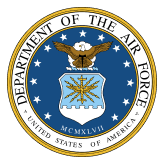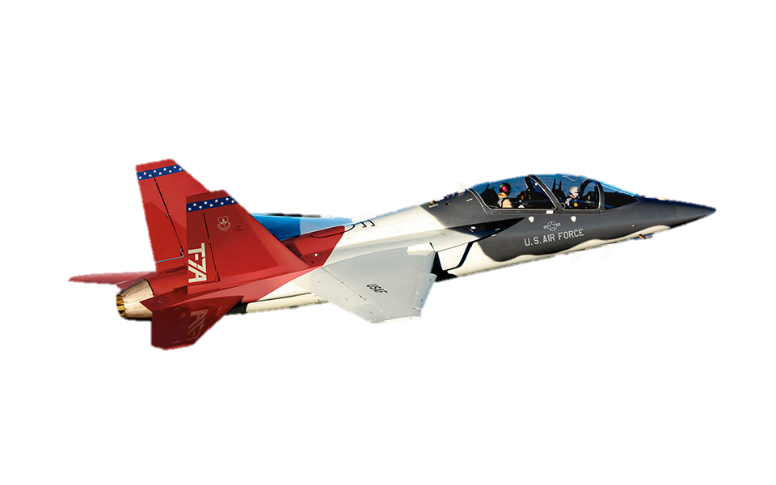
T-7A Recapitalization
Environmental Impact Statement

Joint Base San Antonio
About
Introduction
The National Environmental Policy Act (NEPA) was enacted to address concerns about federal actions and their effects on the environment. An Environmental Impact Statement (EIS) is the most detailed analysis prescribed by regulations implementing NEPA. An EIS is a public document and public involvement is a vital component of the NEPA process.
The Department of the Air Force (DAF) has published a Notice of Intent to prepare an EIS, pursuant to NEPA, for the proposed Joint Base San Antonio (JBSA) T-7A Recapitalization. The Proposed Action includes the introduction of the new generation T-7A training aircraft and associated construction and renovation of support facilities at JBSA-Randolph.
Background
The DAF will recapitalize the T-38C aircraft fleet with the T-7A aircraft at Specialized Undergraduate Pilot Training Bases. Program-wide, the DAF will procure approximately 350 T-7A aircraft. The new T-7A aircraft will allow DAF pilots to train more efficiently and effectively to fly 4th and 5th generation DAF aircraft. Other benefits of the T-7A aircraft include improved technology and improved maintenance leading to less downtime of the aircraft and increased simulator training in the pilot training program. The DAF installations scheduled to undergo T-7A recapitalization include JBSA, Texas; Columbus Air Force Base (AFB), Mississippi; Laughlin AFB, Texas; Sheppard AFB, Texas; and Vance AFB, Oklahoma. Deliveries of the new aircraft will start in fiscal year (FY) 2023.
To prepare for accepting the T-7A aircraft, the DAF developed a geographically phased replacement plan that initiates T-7A aircraft replacement activities at JBSA-Randolph before the other training locations because JBSA-Randolph conducts the majority of the DAF’s Pilot Instructor Training (PIT) and is an Introduction to Fighter Fundamentals (IFF) training location. The Secretary of the Air Force has since named JBSA-Randolph as the first location to undergo T-7A recapitalization. Initial basing of T-7A aircraft at JBSA-Randolph would be an essential first step in establishing a T-7A PIT pipeline and would allow for the transition to T-7A training at the other four pilot training bases that will be used for the T-7A Advanced Pilot Training Program.
Proposed Action
The Proposed Action is T‑7A recapitalization at JBSA using 72 T-7A aircraft and sufficient operations to fully meet all T-7A training requirements. The T-7A aircraft would be assigned to JBSA-Randolph where primary flight operations would occur. Secondary flight operations would occur at JBSA-Lackland, Seguin AAF, and within the existing designated airspace where T-38C aircraft currently operate. The initial delivery and operation of T‑7A aircraft would occur in 2023. T‑7A aircraft operations would be phased in with both T‑38C and T‑7A operations occurring simultaneously through 2031. All flight operations would take place within existing airspace and no additions to, or alterations of airspace would occur under the Proposed Action. Facility construction and upgrades through six major construction projects and 13 minor renovation projects would be implemented and coordinated with T‑7A aircraft arrival.
Alternative 1 – Conduct T-7A Operations at a Lower Intensity than the Proposed Action with Fewer Aircraft to Comply with the Clean Air Act (CAA) Conformity Requirements: After the public scoping period ended and initial impact analysis began, DAF determined that emissions of an ozone precursor from operations of the T-7A aircraft at the intensity of the Proposed Action would exceed the 100 tons per year (tpy) allowable limit for new sources in a nonattainment area in 2027 and later. To remedy this situation, DAF calculated the allowable number of T-7A aircraft and aircraft operations that would result in emissions less than the prescribed limit and allow the recapitalization efforts to be implemented at JBSA-Randolph. The number of aircraft and intensity of operations under this alternative, if selected, would be adequate to meet training and basing requirements until 2026. This timeframe allows for the transition of aircraft to begin at JBSA-Randolph and conduct training operations with ozone precursor emissions below the 100 tpy limit within Bexar County. This timeline also aligns with planned re-evaluation of air quality in Bexar County for attainment/nonattainment categorization. In Section 3 of the Draft EIS, discussion of mitigation and adaptive management strategies are addressed as concurrent actions that may occur and further analyzed to define the allowable level of future T-7A operations beyond 2026. Training and basing requirements would need to be reassessed consistent with the general conformity requirements, as identified in 42 United States Code § 7606 (c) [CAA § 176(c)], that are applicable to Bexar County at the time of reassessment, if required. These additional concurrent actions are discussed as adaptive management measures and also included in Section 3. Under Alternative 1, JBSA-Randolph would receive up to 56 T-7A aircraft with all aircraft arriving no later than 2028.
Alternative 2 – Perform T-7A Operations at an Intensity 15 Percent Greater than the Proposed Action: Like the Proposed Action, JBSA-Randolph would receive 72 T-7A aircraft with all aircraft arriving no later than 2028; T-7A operations would reach full capacity in 2032; and T‑38C operations would conclude in 2031. However, under Alternative 2, beginning in 2024 T‑7A aircraft would perform annual operations at JBSA-Randolph, JBSA-Lackland, and Seguin AAF at an intensity that is approximately 15 percent greater than the Proposed Action. Alternative 2 is intended to cover a potential scenario in which, for either broad strategic or tactical operational reasons, DAF requires a surge or increase in pilot training operations above the program implementing plan and is represented by the 15 percent increase. T-7A nighttime operations would occur with up to 6,569 nighttime operations at JBSA‑Randolph and up to 331 nighttime operations at JBSA-Lackland.
Alternative 3 – Perform T-7A Operations at an Intensity 25 Percent Greater than the Proposed Action: Like the Proposed Action, JBSA-Randolph would receive 72 T-7A aircraft with all aircraft arriving no later than 2028; T-7A operations would reach full capacity in 2032; and T‑38C operations would conclude in 2031. However, Alternative 3 would further increase the surge or increase of T‑7A operations to approximately 25 percent above the Proposed Action beginning in 2024. T‑7A nighttime operations would occur with up to 7,140 nighttime operation at JBSA‑Randolph and 360 nighttime operations at JBSA-Lackland.
FAQs
What is NEPA?
The National Environmental Policy Act (NEPA) of 1969 was enacted to address concerns about environmental quality. NEPA's main objectives are as follows:
- Ensure that federal agencies evaluate the potential environmental impacts of proposed programs, projects, and actions before decisions are made to implement them
- Inform the public of proposed federal activities that have the potential to affect the human environment, including the natural and physical environments
- Encourage and facilitate public involvement in the decision-making process
NEPA requires a federal agency to analyze impacts from a proposal and its alternatives, and provides the public with opportunities to participate in the process.
What is an EIS?
An EIS is a detailed public document describing a proposed action, all alternative actions that were considered, and the environmental impacts of implementing the proposed action and reasonable alternatives.
Regulations specify that an EIS be prepared when a federal agency proposes a major action with the potential to significantly affect the quality of the human environment. An EIS is required to “provide a basis of consideration and inform decisionmakers and the public of the reasonable alternatives.”
What is the T-7A?
The T-7A is a new type of aircraft that the Department of the Air Force will use for pilot training. The T-7A will enable pilots to train more efficiently with modern avionics better preparing them to fly 4th and 5th generation aircraft.
Why is T-7A Recapitalization Needed?
The T‑38C is nearing the end of its service life and is incurring greater maintenance requirements as it ages. Greater maintenance issues lead to more down time of the aircraft, which threatens the availability of pilot training hours. Training with the older T‑38C fails to prepare pilots for the technological advancements of fifth generation aircraft including nighttime flight training. Training systems provided with the new T‑7A aircraft will allow for enhanced and increased simulator training. As a result, the T‑7A recapitalization program will allow the USAF top provide more efficient and effective pilot training for operating fifth generation aircraft.
Why was JBSA Selected for Recapitalization?
JBSA conducts the majority of the Air Force’s Pilot Instructor Training (PIT) and is an Introduction to Fighter Fundamentals (IFF) training location. Initial basing of T-7A aircraft at JBSA would be an essential first step in establishing a T-7A PIT pipeline and would allow for the transition to T-7A training at the other four pilot training bases that will be used for the T-7A Advanced Pilot Training Program.
What is the T-7A Recapitalization EIS Schedule?
The Notice of Availability for the Final EIS was published on March 4, 2022. After a 30-day waiting period, the Department of Air Force signed and released the Record of Decision for implementation of the T-7A Recapitalization effort at JBSA-Randolph.
The discussion on aircraft noise is very confusing, where can I learn more about the subject?
The Department of Defense has developed a guide on military noise management for communities. You may view the guide at this link.